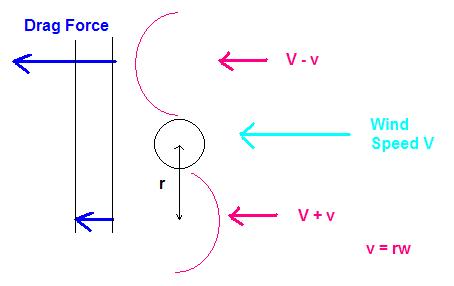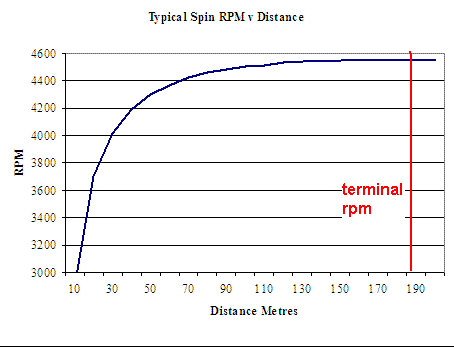
At the Beijing Olympics the majority of archers were using spin wing vanes. A few were using K vanes but as far as I am aware all were using curved vanes.
A lot of club archers use, and swear by, offset flat vanes but clearly elite archers prefer curved vanes. The obvious question is why curved vanes are the choice for the elite archer.
There are a few obvious advantages that curved vanes have.
The original Carella patent highlighted the "wind dependant" variable geometry of the Spin Wing. There's probably some truth in this idea but extremely difficult to quantify it. I doubt that this concept is the top of the list in the preference for curved vane fletchings.
The other advantage that curved vanes have over offset flat vanes is in the aerodynamics of how the spin is generated which is the main point of this note,
The aerodynamics of offset flat vanes has been briefly discussed before in the main article. This article highlighted two major drawbacks to the offset flat vane approach:
Curved vanes have neither of these drawbacks.
A purely curved vane (ignoring the "twist" you have with Spin Wings) spins on the same basis as an anemometer or those revolving vertical "S" shaped signs you often see outside garages. Spin is generated, not by having a different air flow angle of attack on opposing vanes (the offset flat vane method) but by opposing vanes having different drag efficiencies (different drag coefficients) because of the vane shape.
The following diagram illustrates the basic spin operation for a curved vane.

The top vane, because the "cup" faces into the air flow has a higher drag coefficient then the lower vane facing in the opposite direction. The drag force on the top vane is therefore higher than the lower vane resulting in a net torque which spin accelerates the arrow. It spins in an anti-clockwise direction as per the drawing. As the arrow spins faster and faster the top vane is moving away from the air flow V at a speed v (w is the angular velocity and r the distance from the vane centre of pressure plane to the arrow axis). The net air flow speed onto the top vane is therefore V-v. As the spin rate increases the net drag on the top fletching decreases. The reverse is true for the lower vane. As the spin rate increases the net air speed on the lower fletching (and hence the drag force on it) increases. At some spin RPM the drag forces on the top and bottom fletchings will become equal and the arrow will have reached a nominal terminal velocity.

Some crude wind tunnel type calculations suggest that for a typical (flat offset
vane) target arrow the flight distance/time required to reach spin terminal velocity is around 100 - 200 metres/ 2 - 5 seconds. Refer to the attached chart. Problems with Spin Wing
type vanes are their complex shape and vane flexibilty so no sensible estimates feasible - by me anyway. Bertil Olssen has made some
wind tunnel terminal RPM measurements for spin wing fletched arrows giving a value of around 5000 RPM.
Some spin measurements with Spin Wing vanes have been made by the Japanese group (see Takeshi Miyazaki reference below). Measurement of the in flight arrow spin rate at a given air flow rate at 58 meters distance (high speed camera) agreed within experimental error with the spin rate for the same air flow rate in a wind tunnel. As arrow spin in a wind tunnel can be assumed to be at the the terminal spin RPM it follows that the ACE/Spin Wing combination had reached spin terminal RPM at a flight distance of 58m.
The important aspects are that because the curved vane surfaces are parallel to the arrow shaft the only axial drag incurred on the fletching surfaces is the insignificant frictional drag. (Not actually true for Spin Wings because of the twist in the vane). For a given required spin rate curved vanes have lower axial drag then an equivalent offset flat vane.
Also the direction of the spin acceleration with the curved vane, unlike the offset flat vane, doesn't depend on the angle between the air flow and the arrow shaft. With a flat vane if the air flow reverses onto the fletching surface, spin braking occurs and the spin acceleration can go negative. With a curved vane if the air flow reverses onto the fletchings, the two fletchings just "switch roles" and the spin acceleration direction is unchanged (Imagine what would happen if the main airflow was going left to right instead of right to left). With the curved vane you get spin acceleration in a constant direction.
While very little serious technical investigation into arrow spinning with curved vanes has been carried out to date (we have the measurements by Bertil Olssen, referenced above, and the comments by Rick McKinney) a group on Tokyo has recently started looking at arrow aerodynamics at a good technical level. One of the topics looked at, if only at a preliminary level to date, has been arrow spinning and for the first time we have some accurate information and data points to go with the theoretical suppositions. Attached are two relevant references.
Last Update 16 February 2015